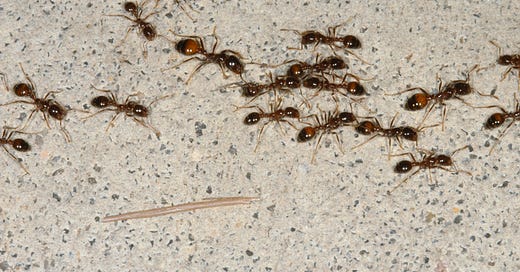Fire Ants used to be a fiery problem in Texas.
Fire ants, gasp, were given credit for electing Jim Hightower to Texas Agriculture Commissioner back in the 80s.
Fire Ants are an invasive species. Texas, being Texas, some proud native Texas fire ants. But the nasty ones originate from Brazil. Now that’s a long walk for an ant, so you might be skeptical. You would be right. The sneaky little ants hitched a ride from Brazil to the Southern states on commercial boats to Mobile, Alabama, and, once here, having no natural predators, began a rampage.
The ants spread and they ate nearly everything in their path. They are aggressive and have a nasty sting. They destroyed plants, commercial and natural. Small kids had to be kept indoors. The fire ant bite was and still is a fearsome thing.
By the time the fire ants got to Texas, they were invading East Texas at 20-30 miles a year. That’s fast for an ant.
It became an issue in the election between Hightower and Reagan Brown.
Brown was dismissive. For a stunt, he stuck his hand in a fire ant. He had to call off all his events for the day and go see a doctor.
Hightower offered his now-famous quip. “You know, Mr. Brown's been saying that I'm not qualified to be agriculture commissioner, but I tell you, I'm smarter than to put my hand on a fire ant mound.” That video of Brown sticking his hand in a fire ant mound still circulates on YouTube.
But the ants were not a joke, they were a major problem. Invasive species, in general, are a problem. It’s not just insects. Some plants are invasive as well. Kudzu springs to mind. These days the prime invasive problem is feral hogs. They have no natural predators. Except man…men like bacon to an enormous degree.
Invasive species are a problem that every Agriculture Department, both state and federal has to deal with.
Wise people say that total eradication is not possible. Total warfare typically causes more damage than the invasive species.
Mirex, a pesticide discovered in 196l, was hailed as a “perfect pesticide” and was utilized as fire ant bait by U.S. Department of Agriculture. It rapidly gained in popularity and became the standard control agent. But the environmental damage was severe. MIrex killed the fire ants and everything else and Mirex stayed active in the ground for a long time.
And it didn’t really work. It did not completely eradicate the fire ants. Some survived and the fire ants continued their rampage.
Texas TDA rose to the occasion in the 1980s. Hightower had heard about Integrated Pest Management. Hightower’s legacy was that he hired interesting and effective folks to staff TDA. One of those “interesting and effective” hires was Ann Sorenson.
“At the time I was doing a postdoctoral fellowship at the University of Georgia. I'd already previously worked in Texas with the Texas A&M University, so I was very familiar with Texas. I was very familiar with fire ants because that was my research focus. I saw an announcement for the job with Jim Hightower. I thought it was really a good time to go back to Texas, and apply what I had already learned through my research on fire ants. It was also just the opportunity to join Hightower, because we had heard about him. We knew that he was having a huge impact in Texas, and I really liked his philosophy and his focus.”
“The minute that I applied, they recognized my name. I think it was probably the fact that I was both an Integrated Pest Management specialist, but I was also known as a fire ant researcher, and I was familiar with the research that was going on in Texas.”
“My focus was on fire ants and I worked with 17 field inspectors in Texas to basically train them to help people around Texas deal with fire ants in a more integrated biologically sane approach to control.”
This following was lifted from Hightower’s Commissioner’s Message on Fire Ants
“As a society, we must begin to consider both the immediate and long-range effects of our actions on irreplaceable soil and water resources.
Now is the time to re-evaluate many of the pest management methods Texans use--whether they are agricultural methods for producing our share of this nation’s food supply or urban methods for controlling roaches or termites in our houses.
Integrated Pest Management, or IPM, is a key to protecting the quality of our state’s agricultural land and urban environment.
IPM is an interdisciplinary, cooperative approach to dealing with our biotic competitors. It involves the development and maintenance of ecologically-sound pest control systems by integrating information from the fields of ecology, sociology, agronomy, biology, and economics. The goal is the discovery and use of pest management alternatives that do not harm humans or the environment, but still allow producers to put some change in their pockets.”
Hightower’s TDA's fire ant program has been praised by USDA and other states as the best in the nation. In the early 1980s, research showed that the large scale aerial applications in the late 1970’s and early 1980’s actually helped the spread of fire ants by killing off competing non-fire ants. As a result of this research, a model program was recommended by the leading scientists from around the country -- a model program that TDA has now implemented.
Feral Hogs
These days the invasive problem is the feral hog. Feral Hogs have no natural predators. They eat what they will and destroy crops and land.
Proposals have been made to poison the heck out of them with warfarin. But those calls have been roundly rejected by farmers. Folks are a bit more sensitive to poisoning the land these days. And then you have the problem of secondary kills. Bald eagles, and other wild animals, might eat the poisoned hogs and die also.
The current TDA commissioner has also advocated helicopter shoots. Fun but also expensive. And you still have to dispose of the carcasses or they will cause problems.
Proposals have also been made to eat them—the bacon solution Feral hogs are great eating. But hogs are, unfortunately, too biologically close to humans. FDA says hogs have to be inspected prior to death as well as after death before human consumption can be approved. Otherwise, your bacon can kill you.
Hogs are also too smart for single traps. They warn their mates not to walk into these contraptions. Huge traps that take the entire herd have been technologically developed. But they are expensive to maintain, and expensive to market. You have to have a truck to haul them away. And there are only a few butchers that will handle feral hogs.
Jesse Griffiths, of Dai Due, talked to People's History in Texas and he believes in Integrated Pest Management. In IPM, you have to understand the life cycle and learn to deal with them. Little fixes.
[As a personal note, I love Dai Due, and I order feral hog…they call them wild boar for marketing purposes… whenever they are on the menu. You should too. Integrated pest management…eat your bacon, like a good environmentalist land manager.]


Dai Due has a Michelin Star
So here is the run-down for managing the invasive feral hog.
Pesticides are not recommended.
“It seems that a lot of landowners are not willing to, especially in the Hill Country, or where you have a really hard topsoil, to bury animals three feet deep. Things like that that are required, along with the very expensive use of warfarin, along with very expensive delivery systems that they have. And I think that many landowners are also a little worried about the possibility of secondary kills, even if it was raccoons, things like that. The Grail when we were opposing warfarin the first time was to get a photograph of a bald eagle scavenging a feral hog carcass, because that would have put an end to it then and there.”
Technological improvements with trapping will work but takes time.
Monetize it with Helicopter shoots
“Helicopter control is highly effective in getting an area really clear of feral hogs, or even a temporary exclusion of them. It can be very effective. It’s sold as fun. I don't know if that's the proper term. It sold as an activity. It's very expensive, and it's definitely not done for just control purposes. I do know of a few properties that have utilized that
Monetize it by selling the meat.
“Now we've got a different situation with these animals and also a closed system and getting them into the food system. We have to go through a lot of regulations to enable it. A trapper who might be his only job, goes out, checks traps, gathers them in a trailer, transports them to a licensed processor, sells them by live weight to him for pennies per pound, and then a lot of those hogs are exported to China and Germany where the flavor of them is actually appreciated. Even the stronger flavored hogs are more appreciated by those cultures. Parts of Europe, it's been long consumed meat over there.
Now we've got some export market and then a little bit of a market for them in the United States. You've got a couple of companies that are doing that trapping, distributing, almost always out of Texas. There might be a little bit in Florida, but most of your commercial hog-trapping and processing businesses are going to be located in Texas. The ones that we deal with obviously are here.”
Jesse Griffiths also recommends food banks. Volunteers trapping feral hogs, taking them to dedicated butchers, and then delivering them to food banks. This is something a state agency could help facilitate.
All that is a bit wonky, but understanding the habits of the invasive species leads to a control of the population.
I mean…Who remembers fire ants?







I still vividly remember the Brown fire mound debacle — one of those historic goofs that redirect the course of events, like the bungled/accidental opening of the Berlin Wall. Still hard to believe Brown thought he could do that unscathed.